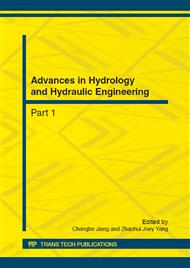p.1233
p.1237
p.1244
p.1249
p.1255
p.1261
p.1267
p.1271
p.1275
Research of Erosion, Cavitation and Their Interactive Wears of Fluid Machinery Three-Phase Flow
Abstract:
There are erosion and cavitation in the wear of flow passage components of fluid machinery at the same time. With simulating the working conditions of hydraulic turbine, this paper studies the flow field (pressure field and fluid concentration distribution) of vapor-liquid-solid three-phase on the surface of test rotary table when there are erosion, cavitation and interactive wear on the test rotary table under different environmental pressure with computational fluid dynamics i.e. CFD method, and erosion and cavitation interactive wear test is made on the rotary wear test-bed. The results show that during interaction, the pressure on test piece surface is higher than that in erosion and cavitation, and both high pressure area and bubble area appear near the cavitation hole which is shown as fish-tail shape; with the environmental pressure increased and the interaction, the pressures on test piece surface and bubble are increased, and wear is thereupon increased; Under the interaction, the numerically computational area with many bubbles and big pressure gradient is basically the same as test piece wearing area, so the numerical computational results are consistent with the test results well.
Info:
Periodical:
Pages:
1261-1266
Citation:
Online since:
October 2012
Authors:
Price:
Сopyright:
© 2012 Trans Tech Publications Ltd. All Rights Reserved
Share:
Citation:


